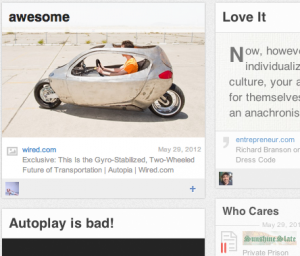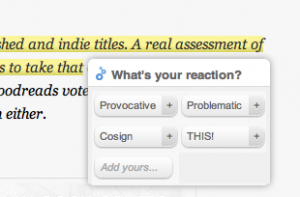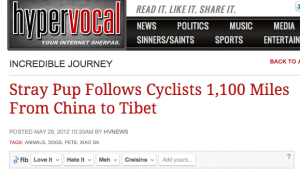Brands
ReadrBoard: Getting Past ‘Like’
How many times have you had the experience of being on Facebook and wishing there was a “dislike” button? Or some alternate way to react to something beyond clicking the infamous thumbs up?
 That’s the idea behind ReadrBoard, a new social tool that lets readers react to anything online – an article, a photo, a video, even a specific snippet from a page.
That’s the idea behind ReadrBoard, a new social tool that lets readers react to anything online – an article, a photo, a video, even a specific snippet from a page.
“Our high level goal to make it simple for people to express themselves in a way that’s satisfying,” says Porter Bayne, co-founder of ReadrBoard along with Eric Chaves and Michael Shaw.
From a business model standpoint, Bayne says ReadrBoard is a tool for online publishers frustrated with the user engagement tools they’re using.
How it works
ReadrBoard’s service is two fold: For the publisher, and for the everyday content consumer.
On the publisher side, a simple line of code can be added to a page to activate the feedback mechanism that captures what readers react to, ultimately helping to drive future editorial decisions.
![]() Publishers can customize their reactions buttons to be anything from “LOL” or “Seriously?!,” to “Must-Read!” or “Meh” — the idea is to match their tone and style. Once users choose the appropriate reaction button, they are provided with the opportunity to add their own commentary, and share it with others.
Publishers can customize their reactions buttons to be anything from “LOL” or “Seriously?!,” to “Must-Read!” or “Meh” — the idea is to match their tone and style. Once users choose the appropriate reaction button, they are provided with the opportunity to add their own commentary, and share it with others.
Beyond giving more interactivity to their readers, publishers are given valuable data and analytics reporting from ReadrBoard, which shows what content is being reacted to, commented on, and shared, and by whom.
“Over time, it will evolve substantially,” says Bayne.
 For individual users, Readrboard’s “React Button” goes in the browser toolbar, and allows you to select specific things of interest on a page — you can clip out one quote if you want — and share your reaction to it with your network, similar to the “Pin It” button, only with more functionality.
For individual users, Readrboard’s “React Button” goes in the browser toolbar, and allows you to select specific things of interest on a page — you can clip out one quote if you want — and share your reaction to it with your network, similar to the “Pin It” button, only with more functionality.
Company advisor, Alexis Ohanian, best known in the industry as the co-founder of Reddit, pushed for this end user component of Readrboard.
“We met with him in April demoing our suite of tools,” says Bayne. “He convinced us to make the button.”
The challenges
Of course, there’s more to the back-end technology than a few call-to-action buttons.
“Our biggest challenge is design because we’re trying to make something that’s really complex that’s push-button easy,” says Bayne.
In fact, the idea for ReadrBoard sprung from a former start-up venture of Bayne’s called Ameritocracy that never quite reached its potential because, he said, of its complexity and design flaws. Over the last almost two years, the technology and design has evolved.
“It’s definitely more complicated than a ‘like’ button,” he says.
Now that the ReadrBoard team is satisfied with the development of the product, pitching the concept to publishers — even getting in to see them — is the next obstacle. Because there are so many ideas out there, some of the reaction has been, “Another tool? Why would I use this? How is it different from Pinterest?”
 Bayne says a quick demonstration illustrates what sets ReadrBoard apart.
Bayne says a quick demonstration illustrates what sets ReadrBoard apart.
Some of the notable publishers that have incorporated ReadrBoard onto their sites include the Iowa Gazette, Racialicious.com, and HyperVocal.com.
“The op-ed section of the Iowa Gazette just called last week that they were frustrated with comments in general,” Bayne said. “What they liked is that they see more activity and engagement with ReadrBoard, but also a higher quality of participation. That’s been true about most of our publishers.”
What’s next
As offered now, Readrboard is a free tool for users and publishers.
“Premium services will be offered over time,” Bayne said. “For sites with 1 to 20 million users – that’s a lot of data, there will be cost involved.”
Over the next few months, the goal is simply to get the word out and get more publishers and users on board. Further on into the future, Bayne says they’re counting on the fact that companies will look for quality-oriented metrics to grow their businesses. So not just the number page impressions, but what people really thought about the content presented on that page will become increasingly important.
“We’re hopeful that our data will help publishers say users respond to this type of content,” he said.
In a sea of widgets, browser toolbar add-ons, comment plug-ins, and social media profiles, anything new is a tough sell. Bayne and his team are hoping their social savviness and quirky style (the website promises “we’ve got some analytics for you that will make you swoon”) will be a welcome addition to online communities everywhere.
Maybe people will even “like” it.

Get better at your job right now.
Read our monthly newsletter to master content marketing. It’s made for marketers, creators, and everyone in between.




